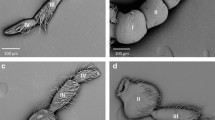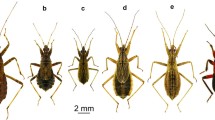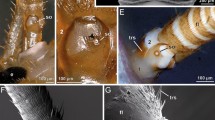Summary
At the apex of the pedicel in Chrysopa there are five campaniform sensilla, which are arranged in a cycle. They are composed of four cells: two enveloping cells, a “trichogen cell” (= accessory supporting cell, Stuart and Satir, 1968) and one sense cell. The distal nerve process contains a transformed cilium. The tip of the cilium with the so called “tubular body” is enveloped by a cuticular sheath.
Zusammenfassung
Der Pedicellus der Florfliege (Chrysopa) enthält an seinem Distalende fünf campaniforme Sensillen. Sie bestehen aus vier Zellen: einer Sinneszelle, einer „trichogenen Zelle (= accessory supporting cell Stuart u. Satir, 1968) und zwei Hüllzellen. Im rezeptorischen Fortsatz der Sinneszelle wurzelt ein umgewandeltes Cilium, dessen Distalende von einer cuticularen Scheide umhüllt wird.
Similar content being viewed by others
Literatur
Debauche, H.: Recherches sur les organes sensoriels antennaires de Hydropsyche longipennis Curt. (Trichoptera-Hydropsychidae). Cellule 44, 45–83 (1935).
—: Étude cytologique et comparée de l'organe de Johnston des insectes. II. Cellule 45, 77–148 (1936).
Dethier, V. G.: The physiology of insect senses. London: Methuen 1963.
Gewecke, M., u. D. Burckhardt: Bau und Bewegung der Antennen von Calliphora erythrocephala. Z. vergl. Physiol. 49, 521–524 (1965).
Henke, K., u. G. Rönsch: Über Bildungsgleichheiten in der Entwicklung epidermaler Organe und die Entstehung des Nervensystems im Flügel der Insekten. Naturwissenschaften 38, 335–336 (1951).
Lees, A. D.: Homology of the campaniform organs on the wing of Drosophila melanogaster. Nature (Lond.) 150, 375 (1942).
Moulins, M.: Les cellules sensorielles de l'organe hypopharyngien de Blabera craniifer Burm. (Insecta, Dictyoptera). Étude du segment ciliaire et des structures associées. C. R. Acad. Sci. (Paris) 265, 44–47 (1967).
—: Les sensilles de l'organe hypopharyngien de Blabera craniifer Burm. (Insecta, Dictyoptera). J. Ultrastruct. Res. 21, 474–513 (1968).
Nicklaus, R., P.-G. Lundquist u. J. Wersäll: Die Übertragung des Reizes auf den distalen Fortsatz der Sinneszelle bei den Fadenhaaren von Periplaneta americana. Verh. Dtsch. Zool. Ges. Heidelberg (1967). Zool. Anz. 31, Suppl., 578–584 (1968).
Pringle, J. W. S.: Proprioreception in insects. II. The action of the campaniform sensilla on the legs. J. exp. Biol. 15, 114–131 (1938).
Schlegel, P.: Einzelableitungen von einem Stellungsrezeptor im Pedicellus-Funikulus-Gelenk des blauen Brummers (Calliphora vicina Rob. Desv. erythrocephala auct). Z. vergl. Physiol. 55, 278–285 (1967).
Schmidt, K.: Die Entwicklung der Scolopidien im Johnstonschen Organ Aëdes aegypti während der Puppenphase. Verh. Dtsch. Zool. Ges. Heidelberg (1967). Zool. Anz. 31, Suppl., 750–762 (1968).
Schneider, D., u. K.-E. Kaissling: Der Bau der Antenne des Seidenspinners Bombyx mori L. II. Sensillen, cuticulare Bildungen und innerer Bau. Zool. Jb., Abt. Anat. Ontog. Tiere 76, 223–250 (1957).
Slifer, E. H., J. J. Prestage, and H. W. Beams: The chemoreceptors and other sense organs on the antennal flagellum of the grasshopper (Orthoptera; Acrididae). J. Morph. 105, 145–191 (1959).
Stuart, A. M., and P. Satir: Morphological and functional aspects of an insect epidermal gland. J. Cell Biol. 36, 527–549 (1968).
Thurm, U.: Mechanoreceptors in the cuticle of the honey bee: Fine structure and stimulus mechanism. Science 145, 1063–1065 (1964).
—: An insect mechanoreceptor. Part I: Fine structure and adequate stimulus. Cold Spr. Harb. Symp. quant. Biol. 30, 75–82 (1965).
Author information
Authors and Affiliations
Additional information
Die Untersuchung wurde mit Unterstützung durch die Deutsche Forschungsgemeinschaft durchgeführt.
Rights and permissions
About this article
Cite this article
Schmidt, K. Die campaniformen Sensillen im Pedicellus der Florfliege (Chrysopa, Planipennia). Z. Zellforsch. 96, 478–489 (1969). https://doi.org/10.1007/BF00335220
Received:
Issue Date:
DOI: https://doi.org/10.1007/BF00335220




